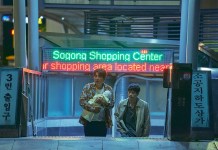Valdimar Jóhansson’s superb debut feature is a story that seems taken from an Icelandic fable as old as the hills whilst being as new and exciting as any film seen this yearin Cannes (where it is screening in the Un Certain Regard section). With three strong central performances and some stunning surprises, not to mention the added bonus of excellent cameos from a dog, a cat and a flock of sheep, this film is not to be missed.
The story is hard to tell without giving away too many spoilers, but the basic premise is this: a childless couple, Maria (Noomi Rapace) and Ingvar (Himir Snær Guðnason), living on a sheep farm deliver a lamb during lambing season that they decide to take into their home and raise as their own child. Up to this point, the pair have been going about their farming duties and live in a fairly quiet harmony together, yet when Ingvar talks about an article discussing the possibility of time travel and states he doesn’t fancy heading to the future much, Maria replies that she would like to return to the past. In the ensuing silence, the farmhouse’s lack of the raucous sounds of children and family life is deafening. And when we watch the two helping the ewes give birth, the irony of them being surrounded by so much life and fertility seems suddenly awful.
 Rapace, who grew up in Iceland and is perfectly at home with the Icelandic language, and Haraldsson have obviously done their homework preparing for this film: we see them driving tractors, mucking out and caring for the sheep, both of them delivering lambs and caring for the newborns. Their relationship is one of tranquil togetherness suffused with the melancholy of that missing child.
Rapace, who grew up in Iceland and is perfectly at home with the Icelandic language, and Haraldsson have obviously done their homework preparing for this film: we see them driving tractors, mucking out and caring for the sheep, both of them delivering lambs and caring for the newborns. Their relationship is one of tranquil togetherness suffused with the melancholy of that missing child.
When the baby lamb enters the family home, another interloper also appears: Ingvar’s naughty brother Pétur (Björn Hlynur Haraldsson) has come from town, dumped on the road by his mates. They are all tattoos, tight black jeans and too cool for school, so when Pétur makes his appearance, there is a fear that the precarious equilibrium of the new family will be lost. Instead, after Pétur’s initial shock at the sight of his new ‘niece’, the three adults slip into a happy routine, Pétur accepting that the new baby is bringing the couple a newfound joy.
Rather than a dramatic fight or an intervention following the revelation that a lamb is in the home, the director simply lingers on Pétur’s face as he quietly absorbs the shock of his brother’s new reality. In fact, there is a lot of humour here, much of it thanks to Pétur. One night, Maria puts on a video of him performing in a band, and the terrible pop video is a delight to watch, as is the older, more grizzled Pétur re-enacting the dance moves in the living room.


This is an intelligent and hugely entertaining film that quietly creates a bucolic horror and has much of the ancient fairy tale about it. It deals with important questions such as motherhood, family and happiness, as well as the lengths people will go to when they see any of those things slipping from their grasp. It is a film about grief, but it is full of fun. It joins Rams in that hallowed pantheon of Icelandic films about sheep, a genre that is rapidly turning out to be one of my favourites.






